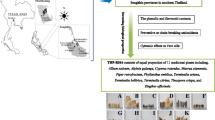Summary
The biologically important components ofHelichrysum arenarium (L.) Moench are the flavonoids, which may have choleretic, hepatoprotective and antimicrobial properties. During our study, we examined the flavonoids present in the lyophilizate of the inflorescence ofHelichrysum arenarium (L.) Moench (Helichrysi flos, syn.Stoechados flos) and in the tea made from the inflorescence via qualitative and quantitative analysis, and determined the flavonoid content. We examined the properties of the lyophilizate antioxidant, and measured the H-donor activity, reducing power property and total scavenger capacity via spectrophotometric and chemiluminescent methods. We compared the results with those of the agent present in milk thistle (Silybum marianum L.), the silibinin flavonoid. Regarding the H-donor activity, our lyophilizate was determined to be more effective than the silibinin at the same amounts; on the other hand, its reducing power property and total scavenger capacity was lower than that of silibinin. The flavonoid content, which is responsible for the lyophilizate effect, was found to be 0.47% according to our measurements; it is, therefore, possible that an extract with such a concentration of flavonoids may be of therapeutic benefit.
Similar content being viewed by others
References
Roth H.J., Schmid W. (1976): Hagers Handbuch der Pharmazeutischen Praxis. Berlin: Springer, 34–37.
Pharmacopoeia Helvetica, 7th edn (1995): Berne: Eidgenössisches Departement des Innern.
Skakun N.P., Stepanov N.Y. (1988): Comparative evaluation of the hepatoprotective, antioxidant and choleretic activity of flavonoid drugs. Vrach. Delo., 12, 52–54.
Vasilév V.N., Preobrazhenskaya N.E., Negrash A.K., Babich L.V., Smirnov V.V. (1987): Isolation of antimicrobic substances from arenarin. Mikrobiol. Zh. (Kiev), 49, 88–91.
Smirnov V.V., Preobrazhenskaya N.E., Marchuk T.L. (1989): Arenarin antimicrobial activity in relation to preparation conditions. Farm. Zh. (Kiev), 4, 61–62.
Vrkoc J., Ubik K., Sedmera P. (1973): Phenolic extractives from the achenes ofHelichrysum arenarium. Phytochemistry., 12, 2062.
Prokopenko O.P., Spiridonov V.N., Litvinenko V.I. et al. (1972): Phenol compounds ofHelichrysum, and their biological activity. Farm. Zh. (Kiev), 27, 3.
Meyer J.J.M., Afolayan A.J. (1995): Antibacterial activity ofHelichrysum aureonitens (Asteraceae). J. Ethnopharmacol., 47, 109–111.
Meyer J.J.M., Afolayan A.J., Taylor M.B., Erasmus D. (1997): Antiviral activity of galangin isolated from aerial parts ofHelichrysum aureonitens. J. Ethnopharmacol., 56, 165–169.
Tomás-Lorente F., Iniesta-Sanmartin E., Tomás-Barberán F.A. Trowitzsch-Kienast W., Wray V. (1989): Antifungal phloroglucinol derivatives and lipophilic flavonoids fromHelichrysum decumbens. Phytochemistry, 28, 1613–1616.
Petri G. (1991): Gyógynövény-és drogismeret. Budapest: Medicina, 173.
Vrkoc J., Dolejs L., Sedmera P., Vasickova S., Sorm F. (1971): The structure of arenol and homoarenol, α-pyrone derivatives fromHelichrysum arenarium L. Moench. Tetrahedron Lett., 3, 247–250.
Derkach A.I., Komissarenko N.F., Chernobai V.T. (1986): Coumarins from inflorescences ofCalendula officinalis andHelichrysum arenarium. Khim. Prir. Soedin, 6, 777.
Deutsches Arzneibuch (DAB 10) (1996): Amtliche Ausgabe. Stuttgart: Deutscher Apotheker Verlag, Frankfurt a.m./Eschborn: Govi-Verlag GmbH.
Wagner H., Bladt S. (1996): Plant Drug Analysis. Heidelberg: Springer, 196–212.
Blois M.S. (1958): Antioxidant determination by the use of a stable free radicals. Nature, 4617, 1198–1200.
Oyaizu M. (1986): Studies on products of browning reaction prepared from glucosamine. Jpn. J. Nutr., 44, 307–315.
Blázovics A., Kovács Á., Lugasi A., Hagymási K., Bíró L., Fehér J. (1999): Antioxidant defense in erythrocytes and plasma of patients with active and quiescent Crohn’s disease and ulcerative colitis: a chemiluminescent study. Clin. Chem., 45, 895–896.
Author information
Authors and Affiliations
Rights and permissions
About this article
Cite this article
Czinner, E., Kéry, Á., Hagymási, K. et al. Biologically active compounds ofHelichrysum arenarium (L.) Moench. Eur. J. Drug Metab. Pharmacokinet. 24, 309–313 (1999). https://doi.org/10.1007/BF03190038
Received:
Issue Date:
DOI: https://doi.org/10.1007/BF03190038



